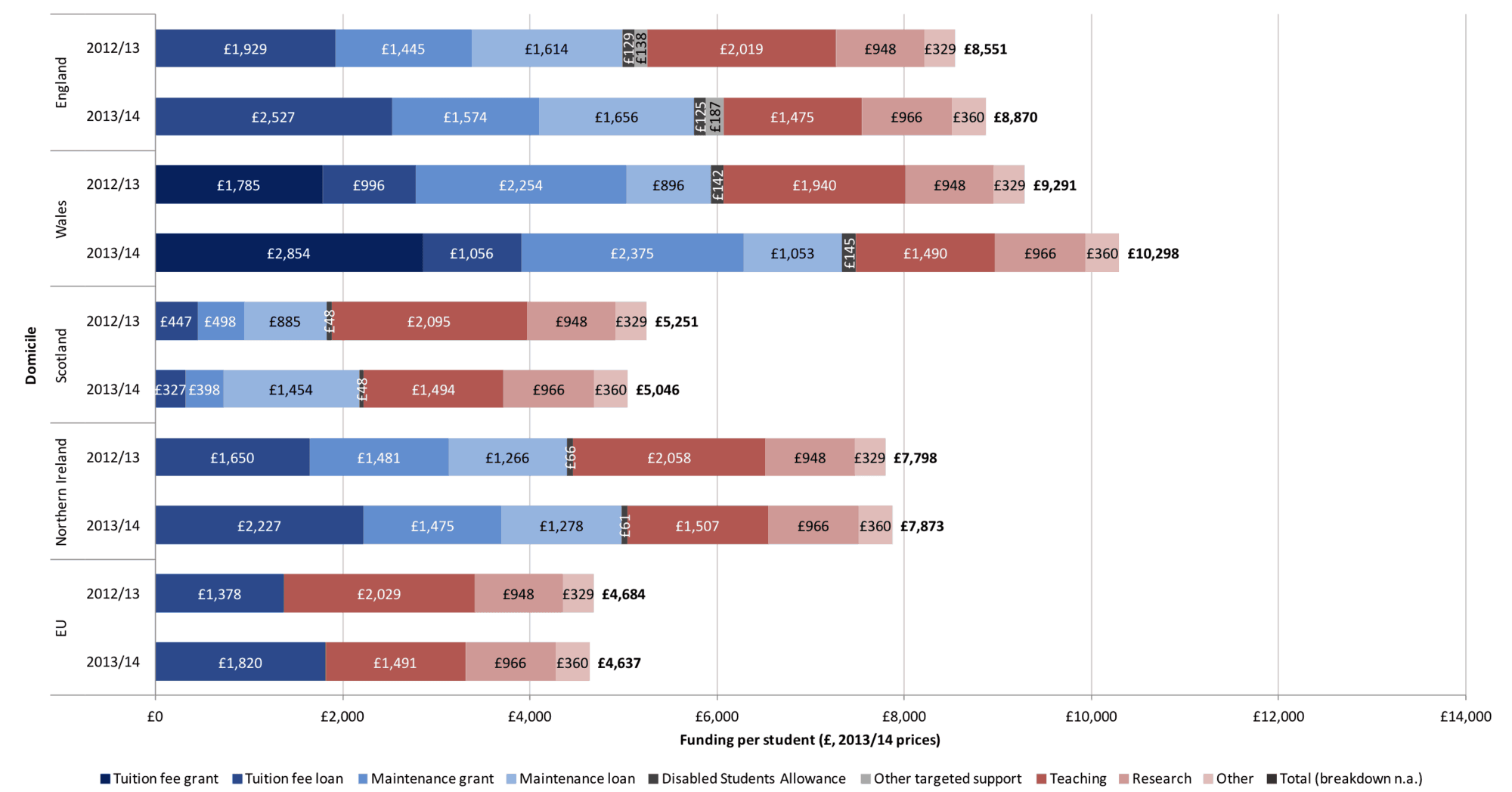As the Spending Review looms, speculation is rife about which areas of public spending are in for the deepest cuts. Sitting within the unprotected Department for Business, Innovation and Skills, budgets for further and higher education look particularly vulnerable – especially in light of proposals for quality-linked tuition fee increases, and the government’s enthusiasm to shift the cost burden towards individuals via loans.
Devolution means that the higher education spending decisions in England aren’t reflected consistently elsewhere in the United Kingdom, but they have certainly had an impact on how the Home Nations have developed their own higher education spending arrangements. So are there lessons to be learned from other Home Nations? A new report by London Economics for the University and College Union sheds light on the consequences of different approaches.
Resource Benchmarking in higher education
The new analysis provides detailed estimates of the funding per eligible learner enrolled in higher education across the four Home Nations of the UK in 2012-13 and 2013-14. Importantly, it considers the source of funding (i.e. whether funding is provided in the form of student support or directly to Higher Education Institutions (HEIs) through block grant funding for teaching, research and other activities via the relevant funding body). How public funding is allocated is important, because given the level of cross-border student flows, the public funding linked with those students enrolled in an HEI outside of their own home domicile varies considerably.
What is the total level of public funding for full-time undergraduates?
Public funding for higher education includes the resources allocated through funding councils, maintenance or tuition fee grants, as well as the proportion of the maintenance and fee loans that are expected to be written off (the so-called RAB charge (which varies considerably by Home Nation)). There are relatively sizeable differences in the level of public funding per eligible student by Home Nation. In 2013-14, the total public funding associated with a full-time English undergraduate student studying in England stood at £8,870 compared to £9,456, £9,016 and £7,721 for comparable Welsh, Scottish and Northern Irish students studying in their own domicile.
What is the relative public and private contribution?
To estimate the private contribution to higher education, we estimate the proportion of maintenance and tuition fee loans that are paid off by students after they graduate. For full-time undergraduates studying in their home domicile, the analysis indicates that in 2013-14, approximately 63% of total higher education funding in England was contributed by the public purse, compared to 37% through private contributions. Compared to England, the public contribution to higher education is proportionately greater in Scotland and Wales (and relatively comparable in Northern Ireland). Specifically, the analysis indicates that the public purse contribution to full-time undergraduate study stood at approximately 70% in Wales in 2013/14, compared to 80% in Scotland and 68% in Northern Ireland.
Public funding per undergraduate full-time student studying at HEI by domicile, country of study, funding item and year (£, 2013/14 prices), and proportion of total funding

What are the differences in how public funding is allocated?
There are also large differences in the funding mechanisms across the Home Nations. In some, public funding is predominantly allocated via the student (through maintenance and tuition fee support), whilst in others resources are predominantly allocated through the higher education funding councils directly to HEIs. The alternative approaches adopted across the Home Nations are important – specifically because of the potential mobility of students and the remaining resources available to host institutions. Resources allocated through student support are generally portable – while allocations through funding councils directly to HEIs in that particular Home Nation are not.
For instance, as a result of the receipt of the non-means tested tuition fee grant, for undergraduate full-time Welsh domiciled students, approximately 81% of public funding is provided through student support, with the remaining 19% allocated to HEIs through the Funding Council. For English domiciled students in England, 68% of public funding is provided through student support (maintenance grants and loans, and tuition fee loans). However, in Scotland and Northern Ireland, the majority of public funding is allocated through the relevant funding council/central government department rather than the student support system (63% for Scottish domiciled students in Scotland and 54% for Northern Ireland domiciled students in Northern Ireland, respectively).
Percentage breakdown of public funding per undergraduate full-time student by domicile, country of study, funding type and year

What about student mobility and cross-border flows? Is there a funding gap?
Given these differences in the means of allocation, and the resulting portability of public funding through student support arrangements, higher education students enrolled in Higher Education Institutions outside of their own Home Nation are associated with markedly different levels of public funding.
For example, irrespective of where they study, Welsh students are eligible for relatively large amounts of portable student support. Welsh higher education students enrolled in England receive approximately £10,298 in public funding (compared to £9,456 associated with Welsh students studying in Wales). In contrast, for English students studying in Wales, total public resources available stand at £7,726.
Because higher education funding in Scotland is predominantly delivered through the relevant funding body directly to institutions, the funding associated with a Scottish student enrolled in England stands at £5,046 – less than half that associated with a Welsh student studying in England.
In the sense that Welsh domiciled students are much more heavily supported and incentivised to pursue their higher education studies anywhere in the United Kingdom (as their high relatively high levels of student support are portable), this suggests that these students are significantly more ‘valuable’ to English HEIs compared to students domiciled in any other Home Nation (including England).
Public funding per undergraduate full-time student studying at HEI in England and Wales, by domicile, funding item and year (£, 2013/14 prices),
Studying in England:

Studying in Wales:
What does all this mean?
In Table 1, we illustrate the number of full-time undergraduates attending higher education institutions across the Home Nations. There is a relatively high number of students moving between Wales and England (in both directions), but a relatively low incidence of students from Scotland studying in England.

Table 2 shows the public resources associated with student support (i.e. the portable element of public funding) dependent on the domicile and location of study, which again illustrates the relatively high proportion of public funding that is allocated to students from Wales, irrespective of where they study.

Combining this information on portable resources, Table 3 below shows that approximately £152.8 million of resources flow from Wales to England (associated with 20,415 students attending HEIs in England), while £181.9 million of resources flow from England to Wales (associated with 30,660 students). Although the average level of student support funding per student associated with English students attending Welsh HEIs (£5,934) is lower than the level of funding per Welsh student attending English HEIs (£7,483) (see Table 2), the number of English students enrolled in Welsh Higher Education Institutions significantly exceeds the number of Welsh students enrolled in English Higher Education Institutions. This difference in student flows results in the level of resource outflow from Wales to England (£152.8 million) being less than the resource inflows from England into Wales (£181.9 million).

For Scottish domiciled students, there is a relatively limited flow of students from Scotland to England (4,695 students). In contrast, as student support arrangements have no differentiating effect on where English students enrol, there are a significantly higher number of English students enrolled in Scottish HEIs (13,975 students). In addition, the average level of support funding per Scottish student attending HEIs in England stands at only £2,227, compared to £5,219 per English student studying in Scotland. The result is that approximately £10.5 million of resources flow from Scotland to England, while £72.9 million of resources flow from England to Scotland.
Conclusions
The level of human capital in an economy is one of the key determinants of economic growth – and the prosperity of everyone in that economy – irrespective of whether they themselves received a university education. As such, the level of public funding for higher education is important. This analysis demonstrates the clear differences in both the level of total funding available within higher education – but also the proportions contributed by individuals privately and the public purse. The analysis also illustrates the fact that the way in which public resources are allocated is important in terms of the incentives offered to students to study in different Home Nations, but needs to be traded off against the remaining public resource available to support institutions at home.












